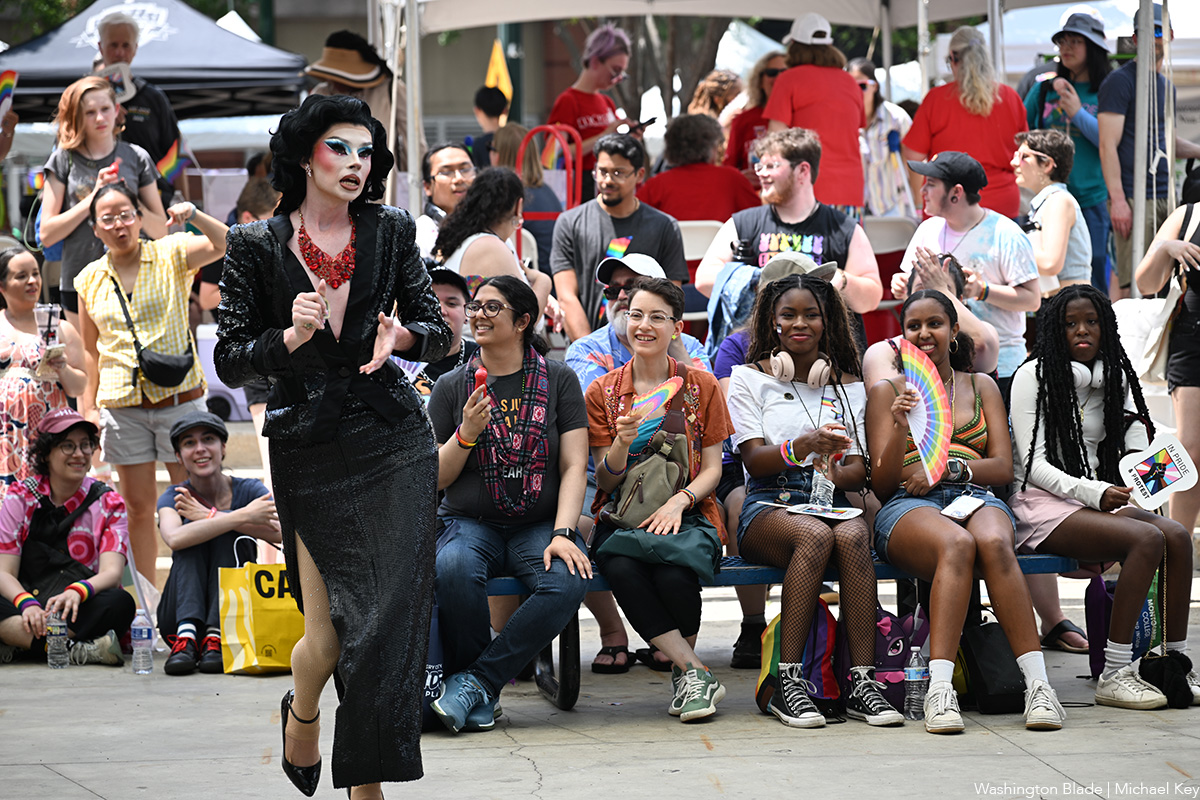Arts & Entertainment
A melodic farewell
Locals lament closure of Dupont Circle record shop

With the rising popularity of downloading music from places like iTunes and online stores like Amazon, more and more record stores are closing, surrendering to the convenience of not having to leave the house to get both new and old albums.
Melody Records, an institution in Dupont Circle since the late ‘70s, is just another casualty in that unfortunate trend. Local gays are lamenting its impending closure. It was always popular with Blade readers — it won several “Best of Gay D.C.” awards in the early ‘00s, which still hang in the store above the new releases.
“Melody Records was one of my first discoveries when I moved to D.C. more than 11 years ago,” Michael Collins, a gay D.C. resident, says. “I stopped there about once a week, sometimes more often than that, and I seldom left empty handed.”
The owners, Suzy and Jack Menase, opened the store in 1977 before moving to Dupont two years later after having to vacate their previous location on E Street when developers wanted to redevelop the area.
“We just found Dupont Circle to be a busy area and thought it would be a good location for us,” Suzy Menase says.
They’ve been in the business so long, they’ve always tried to stay on top of things, and seen all the trends come and go, then come again.
“It’s been like a full circle. We started with vinyl and now we’re ending with vinyl,” Suzy says. “It’s neat to see young kids coming in … they’re not excited about CDs but they’re excited about vinyl.”
“I think the sound quality that they heard made it very attractive,” Jack Menase says.
The store has always held a wide selection of genres, including large sections of seemingly less popular genres such as opera, new age and more.
“The opera queens would squeal while the uber cool disco boys looked for the German imports of what would later be called ‘industrial’ in the specialty bins,” says Stephen Yasko, general manager of WTMD 89.7 in Baltimore.
The Menases have always worked to make sure they have a full selection with a little bit of something for everyone.
“If we don’t have it in stock, we order it for them,” Jack Menase says.
“With CDs, if you can’t sell something, you can return it,” Suzy says. “It’s not one person deciding what we carry.”
The Menases announced they were closing through a letter on their website, saying, “technology, the internet and the economy has taken its toll.”
“In the past two or three years, sales have been declining … we saw it coming, but we were just trying to hold on,” Suzy says. “We have such a strong, loyal customer base, we wanted to stay as long as possible.”
They both remember a time when there was an abundance of record stores in the D.C. area that all survived until the early 90s.
“One by one, everybody closed down,” Jack says.
Being in Dupont, the store automatically became a favorite spot for gay customers.
“Where else could you run across a copy of Ethel Merman’s disco album from the ’70s?” Collins says.
Also, Lambda Rising — a gay bookstore and staple of Dupont Circle — used to be next door.
“We were very sorry to see them go,” Jack says.
“Whoever came to them, whoever came to us went to them,” Suzy says. “They were great neighbors to have.”
Some music lovers continued to purchase CDs — at least in some genres — even into the digital music era.
“I loved Melody,” says Kevin Lees, a gay Washington resident. “I still typically buy classical and sometimes jazz in physical CD format for the copious liner notes and anytime I was looking for something in particular, I would always look at Melody first as my contribution to local stores in the face of Amazon. I’m surprised it lasted so long and that it outlasted Lambda Rising but sadly, the record store is clearly destined to be a thing of the past.”
There are a few members of the staff who have been working at the store for years, including a few who have been around for more than 10 years.
There are a lot of people who have been going to the store for years and some are even on a first-name basis with the Menases.
“They know my whole family and I know theirs,” Suzy says. “It’s not customers, they’re family.”
“I was heartbroken when I saw the going-out-of-business sign on the window,” Collins says. “What a regrettable loss for Dupont Circle and for all Washington music lovers.”
The shop is at 1623 Connecticut Ave., N.W. No firm closing date has been set. For now, it’s open seven days a week from 11 a.m. to 8 p.m.
Photos
PHOTOS: Montgomery County Pride in the Plaza
LGBTQ celebration held in downtown Silver Spring

Montgomery County Pride in the Plaza was held on Sunday, June 29 at Veterans Plaza in Silver Spring, Md.
(Washington Blade photos by Michael Key)























The fifth annual Fredericksburg Pride march and festival was held on Saturday, June 28. A march through the streets of downtown Fredericksburg, Va. was followed by a festival at Riverfront Park.
(Washington Blade photos by Michael Key)



















India
Anaya Bangar challenges ban on trans women in female cricket teams
Former Indian cricketer Sanjay Bangar’s daughter has received support

Anaya Bangar, the daughter of former Indian cricketer Sanjay Bangar, has partnered with the Manchester Metropolitan University Institute of Sport in the U.K. to assess her physiological profile following her gender-affirming surgery and undergoing hormone replacement therapy.
From January to March 2025, the 23-year-old underwent an eight-week research project that measured her glucose levels, oxygen uptake, muscle mass, strength, and endurance after extensive training.
The results, shared via Instagram, revealed her metrics align with those of cisgender female athletes, positioning her as eligible for women’s cricket under current scientific standards. Bangar’s findings challenge the International Cricket Council’s 2023 ban on transgender athletes in women’s cricket, prompting her to call for a science-based dialogue with the Board of Control for Cricket in India and the ICC to reform policies for transgender inclusion.
“I am talking with scientific evidence in my hand,” Bangar said in an interview posted to her Instagram page. “So, I hope, this makes an impact and I will be hoping to BCCI and ICC talking with me and discussing this further.”
On Nov. 21, 2023, the ICC enacted a controversial policy barring trans women from international women’s cricket. Finalized after a board meeting in Ahmedabad, India, the regulation prohibits any trans player who has experienced male puberty from competing, irrespective of gender-affirming surgery or hormone therapy. Developed through a 9-month consultation led by the ICC’s Medical Advisory Committee, the rule aims to safeguard the “integrity, safety, and fairness” of women’s cricket but has drawn criticism for excluding athletes like Canada’s Danielle McGahey, the first trans woman to play internationally. The policy, which allows domestic boards to set their own rules, is slated for review by November 2025.
Bangar shared a document on social media verifying her participation in a physiological study at the Manchester Metropolitan University Institute of Sport, conducted from Jan. 20 to March 3, 2025, focused on cricket performance. The report confirmed that her vital metrics — including haemoglobin, blood glucose, peak power, and mean power — aligned with those of cisgender female athletes. Initially, her fasting blood glucose measured 6.1 mmol/L, slightly above the typical non-diabetic range of 4.0–5.9 mmol/L, but subsequent tests showed it normalized, reinforcing the study’s findings that her physical profile meets female athletic standards.
“I am submitting this to the BCCI and ICC, with full transparency and hope,” said Bangar. “My only intention is to start a conversation based on facts not fear. To build space, not divide it.”
In a letter to the BCCI and the ICC, Bangar emphasized her test results from the Manchester Metropolitan University study. She explained that the research aimed to assess how hormone therapy had influenced her strength, stamina, haemoglobin, glucose levels, and overall performance, benchmarked directly against cisgender female athletic standards.
Bangar’s letter to the BCCI and the ICC clarified the Manchester study was not intended as a political statement but as a catalyst for a science-driven dialogue on fairness and inclusion in cricket. She emphasized the importance of prioritizing empirical data over assumptions to shape equitable policies for trans athletes in the sport.
Bangar urged the BCCI, the world’s most influential cricket authority, to initiate a formal dialogue on trans women’s inclusion in women’s cricket, rooted in medical science, performance metrics, and ethical fairness. She called for the exploration of eligibility pathways based on sport-specific criteria, such as haemoglobin thresholds, testosterone suppression timelines, and standardized performance testing. Additionally, she advocated for collaboration with experts, athletes, and legal advisors to develop policies that balance inclusivity with competitive integrity.
“I am releasing my report and story publicly not for sympathy, but for truth. Because inclusion does not mean ignoring fairness, it means measuring it, transparently and responsibly,” said Bangar in a letter to the BCCI. “I would deeply appreciate the opportunity to meet with you or a representative of the BCCI or ICC to present my findings, discuss possible policy pathways, and work towards a future where every athlete is evaluated based on real data, not outdated perceptions.”
Before her transition, Bangar competed for Islam Gymkhana in Mumbai and Hinckley Cricket Club in the U.K., showcasing her talent in domestic cricket circuits. Her father, Sanjay Bangar, was a dependable all-rounder for the Indian national cricket team from 2001 to 2004, playing 12 test matches and 15 One Day Internationals. He later served as a batting coach for the Indian team from 2014 to 2019, contributing to its strategic development.
Cricket in India is a cultural phenomenon, commanding a fanbase of more than 1 billion, with more than 80 percent of global cricket viewership originating from the country.
The International Cricket Council, the sport’s governing body, oversees 12 full member nations and more than 90 associate members, with the U.S. recently gaining associate member status in 2019 and co-hosting the 2024 ICC Men’s T20 World Cup. The BCCI generated approximately $2.25 billion in revenue in the 2023–24 financial year, primarily from the Indian Premier League, bilateral series, and ICC revenue sharing. The ICC earns over $3 billion from media rights in India alone for the 2024–27 cycle, contributing nearly 90 percent of its global media rights revenue, with the BCCI receiving 38.5 percent of the ICC’s annual earnings, approximately $231 million per year.
Women’s cricket in India enjoys a growing fanbase, with over 300 million viewers for the Women’s Premier League in 2024, making it a significant driver of the sport’s global popularity. The International Cricket Council oversees women’s cricket in 12 full member nations and over 90 associate members, with the U.S. fielding a women’s team since gaining associate status in 2019 and competing in ICC events like the 2024 Women’s T20 World Cup qualifiers. The BCCI invests heavily in women’s cricket, allocating approximately $60 million annually to the WPL and domestic programs in 2024–25, while contributing to the ICC’s $20 million budget for women’s cricket development globally. India’s media market for women’s cricket, including WPL broadcasting rights, generated $120 million in 2024, accounting for over 50 percent of the ICC’s women’s cricket media revenue.
“As a woman, I feel when someone says that they are women, then they are, be trans or cis. A trans woman is definitely the same as a cis woman emotionally and in vitals, and specially, when someone is on hormone replacement therapy. Stopping Anaya Bangar from playing is discrimination and violation of her rights. It is really sad and painful that every transwoman need to fight and prove their identity everywhere,” said Indrani Chakraborty, an LGBTQ rights activist and a mother of a trans woman. “If ICC and BCCI is stopping her from playing for being transgender, then I will say this to be their lack of awareness and of course the social mindsets which deny acceptance.”
Chakraborty told the Blade that Bangar is an asset, no matter what. She said that the women’s cricket team will only benefit by participation, but the discriminating policies are the hindrance.
“Actually the transgender community face such discrimination in every sphere. In spite of being potent, they face rejection. This is highly inhuman. These attitudes is regressive and will never let to prosper. Are we really in 2025?,” said Chakraborty. “We, our mindset and the society are the issues. We, as a whole, need to get aware and have to come together for getting justice for Anaya. If today, we remain silent, the entire community will be oppressed. Proper knowledge of gender issues need to be understood.”
The BCCI and the International Cricket Council have not responded to the Blade’s repeated requests for comment.
-

 U.S. Supreme Court4 days ago
U.S. Supreme Court4 days agoSupreme Court upholds ACA rule that makes PrEP, other preventative care free
-

 U.S. Supreme Court4 days ago
U.S. Supreme Court4 days agoSupreme Court rules parents must have option to opt children out of LGBTQ-specific lessons
-

 Television4 days ago
Television4 days ago‘White Lotus,’ ‘Severance,’ ‘Andor’ lead Dorian TV Awards noms
-

 Music & Concerts5 days ago
Music & Concerts5 days agoBerkshire Choral to commemorate Matthew Shepard’s life











